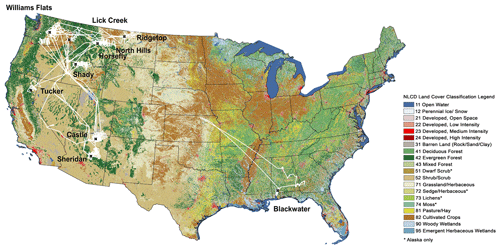
Parameterizations of US wildfire and prescribed fire emission ratios and emission factors based on FIREX-AQ aircraft measurements
Georgios I. Gkatzelis, Matthew M. Coggon, Chelsea E. Stockwell, Rebecca S. Hornbrook, Hannah Allen, Eric C. Ape, Megan M. Bela, Donald R. Blake, Ilann Bourgeois, Steven S. Brown, Pedro Campuzano-Jost, Jason M. St. Clair, James H. Crawford, John D. Crounse, Douglas A. Day, Joshua P. DiGangi, Glenn S. Diskin, Alan Fried, Jessica B. Gilman, Hongyu Guo, Johnathan W. Hair, Hannah S. Halliday, Thomas F. Hanisco, Reem Hannun, Alan Hills, L. Gregory Huey, Jose L. Jimenez, Joseph M. Katich, Aaron Lamplugh, Young Ro Lee, Jin Liao, Jakob Lindaas, Stuart A. McKeen, Tomas Mikoviny, Benjamin A. Nault, J. Andrew Neuman, John B. Nowak, Demetrios Pagonis, Jeff Peischl, Anne E. Perring, Felix Piel, Pamela S. Rickly, Michael A. Robinson, Andrew W. Rollins, Thomas B. Ryerson, Melinda K. Schueneman, Rebecca H. Schwantes, Joshua P. Schwarz, Kanako Sekimoto, Vanessa Selimovic, Taylor Shingler, David J. Tanner, Laura Tomsche, Krystal T. Vasquez, Patrick R. Veres, RebeccaWashenfelder, PetterWeibring, Paul O. Wennberg, Armin Wisthaler, Glenn M. Wolfe, Caroline C. Womack, Lu Xu, Katherine Ball, Robert J. Yokelson, Carsten Warneke
Atmosperic Chemistry and Physics
Atmos. Chem. Phys., 24, 929-956
Publication Date: January 23, 2024
© Author(s) 2024. This work is distributed under
the Creative Commons Attribution 4.0 License.
Abstract.
Extensive airborne measurements of non-methane organic gases (NMOGs), methane, nitrogen oxides, reduced nitrogen species, and aerosol emissions from US wild and prescribed fires were conducted during the 2019 NOAA/NASA Fire Influence on Regional to Global Environments and Air Quality campaign (FIREX-AQ). Here, we report the atmospheric enhancement ratios (ERs) and inferred emission factors (EFs) for compounds measured on board the NASA DC-8 research aircraft for nine wildfires and one prescribed fire, which encompass a range of vegetation types.
We use photochemical proxies to identify young smoke and reduce the effects of chemical degradation on our emissions calculations. ERs and EFs calculated from FIREX-AQ observations agree within a factor of 2, with values reported from previous laboratory and field studies for more than 80 % of the carbon- and nitrogen-containing species. Wildfire emissions are parameterized based on correlations of the sum of NMOGs with reactive nitrogen oxides (NOy) to modified combustion efficiency (MCE) as well as other chemical signatures indicative of flaming/smoldering combustion, including carbon monoxide (CO), nitrogen dioxide (NO2), and black carbon aerosol. The sum of primary NMOG EFs correlates to MCE with an R2 of 0.68 and a slope of −296 ± 51 g kg−1, consistent with previous studies. The sum of the NMOG mixing ratios correlates well with CO with an R2 of 0.98 and a slope of 137 ± 4 ppbv of NMOGs per parts per million by volume (ppmv) of CO, demonstrating that primary NMOG emissions can be estimated from CO. Individual nitrogen-containing species correlate better with NO2, NOy, and black carbon than with CO. More than half of the NOy in fresh plumes is NO2 with an R2 of 0.95 and a ratio of NO2 to NOy of 0.55 ± 0.05 ppbv ppbv−1, highlighting that fast photochemistry had already occurred in the sampled fire plumes. The ratio of NOy to the sum of NMOGs follows trends observed in laboratory experiments and increases exponentially with MCE, due to increased emission of key nitrogen species and reduced emission of NMOGs at higher MCE during flaming combustion. These parameterizations will provide more accurate boundary conditions for modeling and satellite studies of fire plume chemistry and evolution to predict the downwind formation of secondary pollutants, including ozone and secondary organic aerosol.
